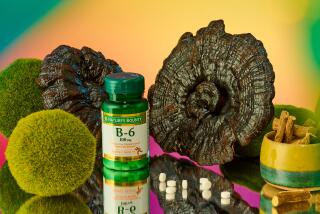Wise Men won’t be bringing these
Health and fitness products can make great holiday gifts. A thoughtfully chosen natural remedy or exercise device sends all of the right messages: I care about you, I want you to feel your best and I don’t want to risk guessing wrong about your sweater size.
But if you give a health product that doesn’t live up to its claims, you end up sending a different message: I didn’t do my homework, sorry for the disappointment and, hey, better luck next year.
In an annual tradition, the Healthy Skeptic has gathered several items that could conceivably end up on a gift list. These products -- a portable oxygen bar, an ionized golf shirt, a beverage that supposedly encourages sleep and a lamp that allegedly chases away the winter blues -- would all look great covered in festive wrapping, but it’s the inside that really counts. On closer inspection, the Healthy Skeptic must repeat the advice he has given in past years: Giver beware.
--
O2-B Personal Oxygen Bar
Oxygen is the ultimate energizer. The gas fuels every cell in the body, giving you the power to move, think and, with luck, finally make your home presentable for out-of-town relatives.
At a time when many of us are looking for an extra energy kick, it’s perhaps not surprising that oxygen has become a sought-after commodity. Oxygen bars -- establishments where you can pop down a few bucks to breathe concentrated O2 -- have opened up across the country. If someone on your gift list isn’t into the bar scene, you might consider giving an oxygen delivery device that can be used at home.
One example is the O2-B Personal Oxygen Bar from O2 Innovations, based in Pittston, Pa. Unlike the oxygen tanks used by people with emphysema or other lung diseases, this device concentrates natural air until it contains 40% oxygen, which is about twice the normal level. The oxygen-enriched air is delivered though a headset that looks a little bit like a hands-free microphone. Users are instructed to breathe the oxygen-heavy air for up to 30 minutes at a time.
The O2-B bar is available at health spas, chiropractors’ offices and even some ski resorts. If you’re looking for a high-end gift, you can buy one online (complete with relaxation CDs) for a little less than $600.
The claims: The O2 Innovation website says that the portable oxygen bar “gives you the energy you’ve been craving” and “replenishes and renews your spirit.” A video says that the oxygen bar would be the perfect solution to afternoon drowsiness at the office.
Because of air pollution, most people don’t get all of the oxygen they really need, says Maryrose Snopkowski, marketing representative for O2 Innovations. According to Snopkowski, just 10 or 20 minutes with the machine can restore their missing oxygen and recharge their bodies.
“I use it all the time,” she says. “It’s a cool little machine.”
The bottom line: Oxygen undoubtedly delivers energy, but it’s highly unlikely that anyone with healthy lungs would get a lift from an oxygen bar, says Janet Pierce, an associate professor of nursing at the University of Kansas Medical Center in Kansas City. “If you’re a healthy person, the hemoglobin in your blood cells is already 98% saturated with oxygen. Getting any more isn’t going to make a difference.”
Pierce put oxygen -- and her own skepticism -- to the test in a 2011 study published in the Journal of Complementary and Alternative Medicine. Thirty young, healthy volunteers spent 10 minutes attached to an oxygen bar. Before and after their oxygen infusion, they filled out questionnaires designed to assess stress, energy and relaxation levels. The oxygen had no measurable effect.
Pierce says there’s a quicker way to pack a little more oxygen into your blood cells: “Just take a deep breath and hold it for three seconds.” You may not feel any more energized, she says, but you can take pleasure in knowing that you saved $600. On the downside, it’s hard to gift-wrap a deep breath.
--
Energy Athletic golf shirt
Whether they’re regulars on the PGA Tour or hacks at the local par 3 course, golfers are always looking for an edge, especially if it doesn’t involve any actual effort. Ionized bracelets and necklaces that supposedly improve swings, balance and stamina have become popular accessories on golf courses. Now there’s a new frontier in golf apparel: ionized golf shirts.
The fabric in the Energy Athletic golf shirt, endorsed by pro golfer and 12-time PGA Tour winner Paul Azinger, is supposedly embedded with an electromagnetic field of negatively charged ions. The shirts, available in several colors, cost about $70 for the short-sleeved version and $80 for the long-sleeved garment.
The claims: A news release announcing the launch of the shirts says the “intelligent fabric stimulates the delivery of oxygen to the muscles through the bloodstream and brain, which is designed to provide golfers with increased energy, strength, focus and accelerated recovery.”
Mike Abram, president of Performance Sports Brands Inc., the Manhattan Beach-based company behind the shirts, passed up a chance to proclaim that the shirts enhance athletic ability. “I’m under wraps about exactly what I can say the shirts do. I can tell you that it feels great. You can just feel something different when you put it on.”
On a testimonial on the company website, a golfer named Paul Broughton says the shirt made him feel “euphoric” and gave him the energy to “play golf all day.”
The bottom line: Athletes through the ages have turned to all sorts of charms and rituals that don’t really do anything, notes Dr. Dennis Cardone, an associate professor of orthopedic surgery who specializes in sports medicine at New York University Langone Medical Center in New York City.
When it comes to performance aids, Cardone believes that Energy shirts belong in the same category as rabbit’s feet and rally caps. “There’s no way these ionized shirts, necklaces or bracelets can make any difference,” he says.
In Cardone’s view, the claim that the electromagnetic field in a shirt could somehow stimulate blood flow to the brain and muscles “does not make any sense, either in terms of physiology or physics.” He notes that MRI machines -- devices that create massive electromagnetic fields -- have no measurable effect on blood flow.
The Energy Athletic shirt may be stylish and comfortable, Cardone says, but sometimes a shirt is just a shirt.
--
Dream Water
You almost never hear anyone complaining about getting too much sleep. So it’s a good bet that a lot of people on your gift list would appreciate anything that helped them sleep better, longer and more deeply. That’s the promise of Dream Water, a liquid supplement from Miami-based Dream Products. Each 2.5-ounce bottle contains a “proprietary blend” of three compounds that often show up in alternative sleep remedies: the hormone melatonin and the brain chemicals GABA and 5-HTP.
Users are instructed to drink a full bottle any time they’re struggling to fall asleep. You can buy a 12-pack for about $40.
The claims: The Dream Water website claims that the three ingredients “work together to help you fall asleep.” The melatonin is said to induce sleep while the GABA reduces anxiety and the 5-HTP improves the quality of sleep.
David Lekach, the chief executive of Dream Products, calls himself “an unfortunate power user of Dream Water.” He says a bottle at night reliably helps him fall asleep. He adds that Dream Water may not work for everyone. “We’re not perfect, but we’ve sold millions of bottles in this country. There’s definitely a demand.”
The bottom line: If a sound night’s sleep is your holiday wish, don’t count on Dream Water, says James Wyatt, director of the Sleep Disorders Service and Research Center at Rush University Medical Center in Chicago.
A fellow of the American Academy of Sleep Medicine, Wyatt has extensively studied melatonin as a potential sleep aid. His conclusion: “It has no impact on nighttime sleep.” As he explains, people make the hormone naturally as night falls, and there’s no correlation between a person’s nighttime melatonin levels and sleepiness. Melatonin can encourage sleep in shift workers who have to sleep during the day, he says, but that’s not exactly the target audience of Dream Water. (With one exception: The website shows a picture of a dozing Santa, the ultimate shift worker.)
Wyatt says there’s also no good reason to think that either GABA or 5-HTP would encourage sleep in anyone. “They’re making health claims without a shred of data,” he says.
--
Sunlight 365 lamp
The holidays aren’t happy for everyone. Many people feel their moods sag as the days get shorter. The lack of daylight makes them listless, irritable and depressed, a condition known as seasonal affective disorder. Doctors often prescribe antidepressants to people with SAD. Light therapy -- sitting next to a bright light for a prescribed amount of time -- is another popular option.
You don’t need to see a doctor to try light therapy -- you can try to treat yourself with the Sunlight 365, an “artificial sunlight” device made by Huntington Beach-based Zadro Inc. The desktop lamp, complete with 35 blue LED lights, is programmable and adjustable. Users are told to sit within arm’s reach of it for 30 to 60 minutes each day “as early in the morning as possible” and glance at it occasionally.
Depending on where you shop, you can expect to pay $40 to $60 for the lamp.
The claims: The Zadro website says that the Sunlight 365 “mimics natural sunlight.” The site also notes that a lack of sunlight can cause “exhaustion, depression, lack of energy or sleep disorders.” A fact sheet provided by company representative Becky Zadro says the Sunlight 365 “provides the benefits and effects of natural sunlight without harmful rays.”
The bottom line: Light therapy is a tried-and-true treatment for people with seasonal affective disorder, says Janis Anderson, an assistant professor of psychology at Harvard Medical School in Boston. Anderson and colleagues have conducted several successful trials of light therapy over the years, but she has significant reservations about the Sunlight 365.
For one thing, the company claims that their lamp produces 10,000 lux of light (a measure of intensity), but Anderson says that’s suspiciously bright for a small table-top array of blue LEDs. In studies, she has had success using lamps with less than 2,500 lux. She also takes issue with the company’s suggestion to use the lamp “as early as possible” in the morning. Waking up early to soak up artificial sunlight could seriously mess with a person’s sleep rhythms, she says. “It doesn’t fill me with confidence that this company knows what it’s doing.”
Anderson cautions that it’s possible to overdose on light therapy, especially if a person is already prone to manic episodes. Overall, she says, seasonal affective disorder is a serious disorder that should be addressed in a doctor’s office, not at the mall.
--
Curious about a consumer health product? Send an email to health@latimes.com.
Read more at latimes.com/skeptic.


